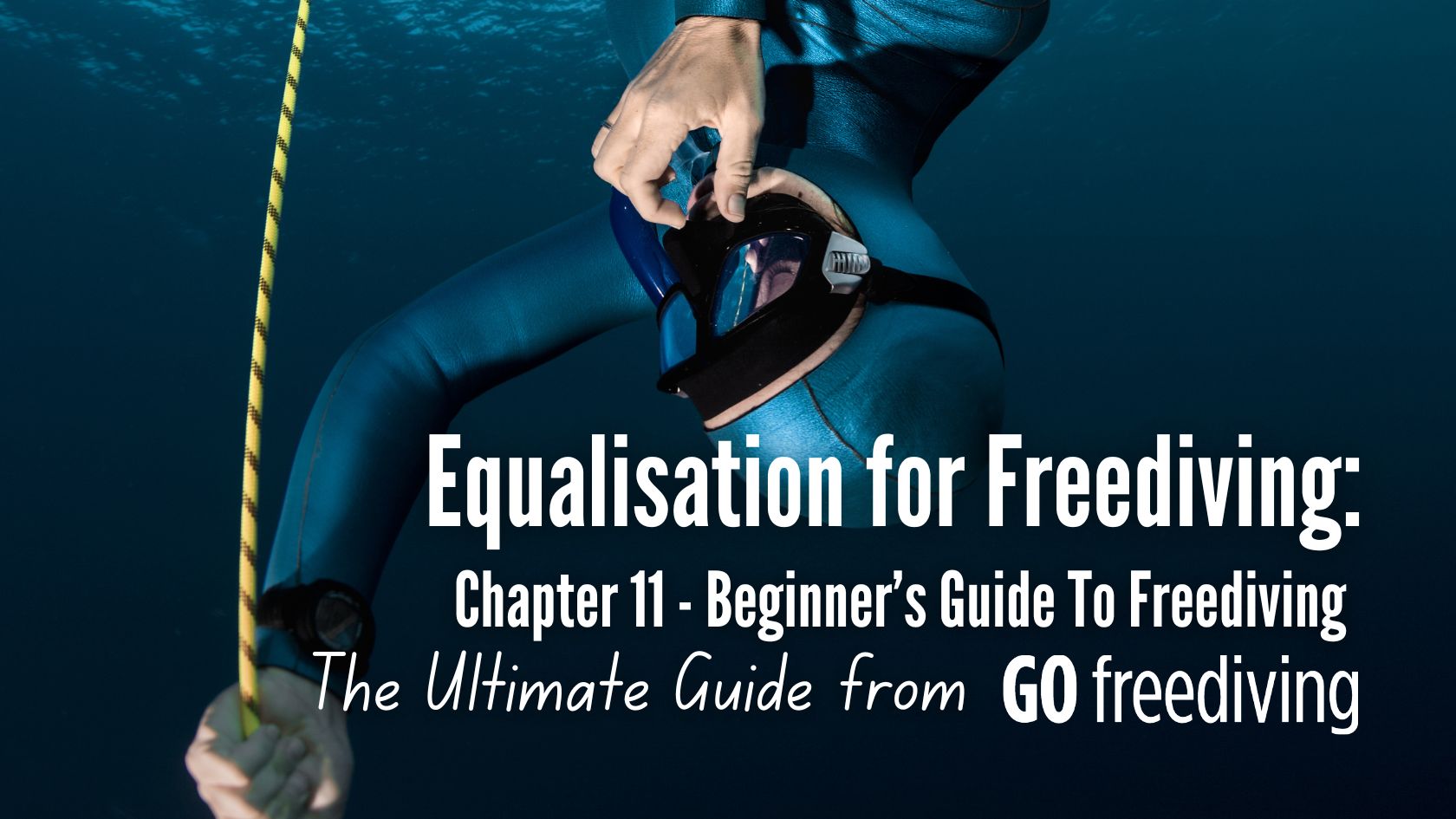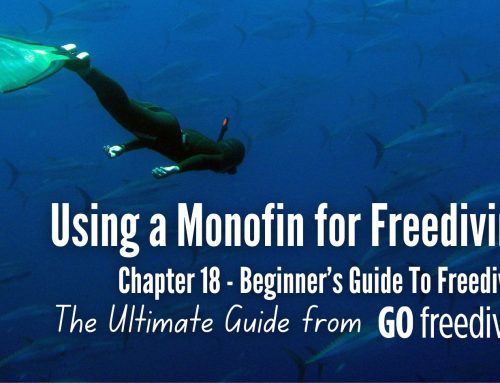Welcome to Part Eleven of The Beginner’s Guide to Freediving, the best place to start your freediving journey. If you’re planning to start freediving, this chapter covers equalization for freediving – why we need to do it, how to do it, and how to avoid equalisation problems.
Introduction To Equalization for Freediving
When I first started freediving I was limited immediately by my inability to equalize the pressure in my ears. I could just about equalize to a depth of a few meters if I hauled myself down feet first, but if I tried to equalize head first then nothing happened. This was incredibly frustrating, compounded by those around me who told me that I would never be able to equalize because there was ‘something wrong’ with my ears. It took almost a year for me to learn how to equalize headfirst and for my body to adapt to being in water and upside down. I always tell students that if I can learn equalization for freediving, then anyone can, and I have never met anyone who cannot learn to equalize for freediving, given enough time and perseverance. Here we will look at how to equalize, the common problems you might encounter, and how you can overcome them.
Equalization for Freediving – What Do We Need To Equalize When We freedive?
Our body contains air spaces and as discussed in the previous article on depth and pressure, when we descend in water, the air spaces inside our body get smaller. If we do not add air into these spaces to compensate – equalizing the pressure within them and bringing them to the same volume we have at the surface – then injury will occur.
The air spaces that need to be equalized when we freedive are our ears, sinuses, mask and lungs. When we talk about equalizing our ears, we are actually referring to our middle ear, located behind your eardrum and connected to the back of your throat via the Eustachian tubes. Our sinuses, meanwhile, are small air cavities in our frontal skull, behind our eyes, nose and cheekbones. They reduce the weight of your skull, humidify the air that we breathe, help prevent infection from the body, insulate the eyes, protect the brain during head trauma and add resonance when we speak or sing.
We need to put air into our sinuses, ears and mask in order to equalize the pressure within them as we descend in order to prevent potentially serious injury.
Equalization for Freediving – Equalizing Our Sinuses When We Freedive
When your sinuses are free from blockage or congestion, they will equalize at the same time as your ears, so we don’t need to think about doing anything specific to equalize them. If there is congestion (such as when you have a cold, for example) however, the air spaces in the sinuses can get blocked, preventing the passage of air. As you descend, the air spaces get smaller and smaller and this can cause pain in your cheeks, eyes and forehead, and occasionally in your teeth and jaw. If you do not equalize, eventually the capillaries in the sinuses burst, releasing blood into them and thus equalizing the pressure. If this happens you will have a nose bleed into your mask.
Many people regularly experience nose bleeds whilst freediving and say that they are not bothered by it and that it does not affect their diving. In my opinion, if there is bleeding from the sinuses then you have injured them and this needs to be prevented from happening.
The first precaution is not to dive when you have a cold or are congested. If you feel that you have blocked sinuses then steam inhalations are a good way to help soften and shift mucous. Put very hot water in a bowl, then lean your face over it and cover your head with a towel. Slowly breathe in the hot water vapor through your nose. Essential oils such as eucalyptus, peppermint, thyme or pine can be added to the water, or prepared blends such as Olbas Oil.
A good preventative measure is sinus washing with a specially prepared bottle or small teapot-shaped object called a neti-pot. You fill the bottle with warm saline solution then plug one nostril and, using gravity, tip your head to the side. The water will run through one nostril, through your sinuses and then out through your other nostril (make sure you do it over a sink). When the pot is empty, refill it and do it again on the other side. Many people use a neti-pot daily to help prevent colds.
If you find you have severe congestion and your doctor has ruled out sinusitis or any other condition, I always recommend people visit a cranial osteopath to see if that can help. Personally speaking, I had a chronic sinus problem that lasted 10 years before I discovered cranial osteopathy, and I have seen many students, including one of my instructors, who always experienced bleeding from their sinuses until they visited a cranial osteopath.
Some people use decongestants to help clear their sinuses before they dive. This can be useful but I always advise against it. Decongestants can wear off during a dive and cause reverse block (more on this later). In addition, they dry out the delicate mucous membranes of the sinuses and as a result can often cause more problems than they seek to solve. Many years ago on an instructor course, I had a candidate who used decongestants every day so that he could complete the performance requirements; he ended up with sinus issues that lasted six months.
My recommendation is always that if something hurts, it is the body telling you that something is not right and you should turn round and come back to the surface. Prevention is always better than cure.
Equalization for Freediving – Equalizing Our Mask When We Freedive
If you wear a mask when freediving then you will need to equalize the air space within it. Freedivers use specialized masks with a low internal volume, as the amount of air they have available to equalize the space in the mask is limited by the air they take down with them. The smaller the volume, the deeper and longer you can dive, as less of your precious air is will be required to equalize your mask. If you fail to equalize your mask, then the capillaries in your eyes will burst due to the negative pressure. To equalize the mask, simply exhale a small amount of air from your nose into it. A common problem is that freedivers either forget to equalize their mask, or they exhale too much air and the excess escapes out of the mask. Every bit of air that you take down with you on a dive is precious and you want to avoid losing any of it. Get your instructor or buddy to check that you are not losing air when you are equalizing.
On the way back up from a dive, the air space in the mask starts to expand. You will see this as escaping air from the mask of a diver. Once you are comfortable and confident with other aspects of your dive, I recommend sniffing this air back in as it starts to expand. As well as replenishing your air, I also feel it gives you a psychological advantage as you almost feel as if you are breathing again.
Some masks, such as the Aqualung Sphera, have plastic lenses and a flexible structure that moulds to your face as you descend, slightly reducing the amount of air needed to equalize. However, they do not suit everyone’s face, cause visual distortion under the water, and the lenses can pop out unexpectedly. Many deep freedivers decide to abandon the mask altogether, saving the air inside their lungs for equalizing their ears only, and use a nose clip and fluid goggles or no goggles at all, but for beginners we recommend sticking with a good quality, low volume mask.
Equalization for Freediving – Equalizing Our Ears When We Freedive
When we talk about equalizing the ears, we mean equalizing the middle ear. This is the area behind the eardrum that leads, via the Eustachian tubes, to the back of the throat.
Most people experience the need to equalize this air space when they are on a plane that is taking off or landing, or in a car going down a steep hill. You get a feeling of pressure in your ears, which can be relieved by chewing, swallowing, yawning or moving your jaw. These pressure changes are slow compared to the ones experienced during a freedive, particularly in the first ten meters, and so most people need to use a more powerful equalization technique.
An interesting experiment to see how easily your Eustachian tubes can open is the hum test. You hum and, whilst humming, move your jaw strongly forward. If the hum gets louder inside your head, on the left or right side or both, then you have opened your Eustachian tubes. If this is tricky then you can try pushing the law forward and to the left to open up the right side and to the right for the left side. I have always found it difficult to equalize my ears, particularly the right one. When I do the hum test, only occasionally I can open up my left Eustachian tube, but never the right.
If you find the hum test tricky, it does not mean that you will be unable to equalize; you just may find that it takes more time to master an equalization technique that works for you. The most common equalization for freediving technique that Scuba divers and people new to freediving use is the Valsalva maneuver. You simply pinch your nose and create pressure from your diaphragm by trying to exhale through your nostrils against your pinched nose. If you try this you will usually feel an inflation in the ears.
This technique works but it is not optimal one freediving. What you should aim to learn is the Frenzel maneuver, which uses the back of your tongue to create pressure in the back of your throat, equalizing your ears while keeping your epiglottis shut. This does not use the diaphragm and can be used to equalize at much deeper depths.
To practice it, start by looking in a mirror at your throat and the area under your jaw. Put the front half of your tongue flat against the roof of your mouth and then repeatedly squeeze the back of your tongue up against the roof of your mouth. Under your jaw you should see an upwards movement corresponding to the movement of the back of the tongue. To do the Frenzel, you still need to pinch your nose, so now half-pinch the nose and do the movement of your tongue again – see if, each time you squeeze the tongue up against the roof of the mouth, a little bit of air escapes from your nose.
If this is tricky, then still half-pinching your nose, slowly let a stream of air out of your nose. Keep the stream going but then bring the back of your tongue up, squeezing more air out of your nose. Experiment with the aid of your instructor, or watch the accompanying video demonstrating the Frenzel.
Equalization for Freediving – Problems With Equalization
There are many issues that people can have with equalization for freediving. Here are some of the most common:
- Failure to equalize frequently enough – In the first 10 meters below the surface, the pressure doubles and you need to frequently equalize. I recommend you keep a hand on your nose at all times, with your elbow tucked into your body for streamlining. Pre-equalize before you leave the surface and again as soon as you have pulled your arms towards your body during the duck dive.
- Equalizing too late – Preempt every equalization. If you feel strong pressure or pain in your ears then you have left equalizing too late and it may become impossible to equalize. Always be ahead of every pressure change.
- Keeping your head raised – Tuck your head in. If you can see where you are going, then your head is raised. Tucking your head in, so it is in line with the rest of the body, takes reduces pressure on your Eustachian tubes and makes equalizing much easier.
- Equalizing only one ear – Make sure you have equalized both ears. If you have a good ear and a bad ear, it sometimes means that you equalize only one but think that you have equalized both. You then reach a depth where suddenly you are aware of intense pain. When starting to freedive, use the rope to pull down slowly. By pulling down you can stop your descent and take time to check that both ears have equalized correctly. You can also try moving your jaw forward and to each side. If you struggle equalizing your right ear, move your jaw forward and to the left to help open up the Eustachian tube on the right side, and to the right to open the left side.
- Do not strain – Equalize gently but effectively. You do not want to strain when equalizing,as this can over-pressurize your ears (in extreme cases blowing them outwards) and can cause reverse block (see below) by creating congestion in the tissues around your Eustachian tubes.
- Unable to equalize – If you cannot equalize, stop and come back to the surface. You want to avoid damaging your ears at all costs.
- Cannot equalize head first – Pulling feet first down the line can be very helpful in learning how to equalize. If this is easy, start descending at an angle, slowly moving to vertical.
Reverse block is a serious situation to find yourself in. It means that the tissues have become so congested around your Eustachian tubes that, as you ascend from a dive, they close. The expanding air inside your middle ear cannot then escape down the back of your throat. As a result, your eardrums bend outwards, and if the pressure is not released then your eardrum will rupture.
If this happens, immediately stop your ascent and hold onto the dive line. Wiggle your jaw and move it forwards as with the hum test above. Do not pinch your nose and try to equalize as this will compound the problem.Ascend as slowly as you can, moving your jaw and you go. If this doesn’t work and you are running out of air, then come straight to the surface, as it is better to have a problem at the surface than at depth.
Another potential issue you may encounter during equalization for freediving is hood squeeze. This is when air is trapped in your outer ear by the hood of your wetsuit. As you descend and this volume reduces, it pulls the eardrum outwards causing pain. If this happens, immediately return to the surface. To prevent this happening, allow water into your hood by your ears as you are breathing up, or use a belt hole punch to cut tiny holes in the side of the hood by your ears to let the water in.
Equalization for Freediving – Tips For Improving Equalization
To help make equalization easier, there are many things that you can do out of the water:
- Stretch the area around your Eustachian tubes – see the previous article on stretching.
- Regularly use a neti-pot and steam inhalations to cleanse your sinuses.
- When flying, cover your nose and mouth with a layer of fabric, as it will trap moisture from your breath and help you breath in humid air.
- Use Docs Pro plugs. These are vented ear plugs that let a very small amount of water into the ear. This prevents repeated flushing of cold water on the eardrum, which can lead to exostosis, where the bone in the ear canal starts growing across the entrance. I use pro plugs even when in tropical waters and find they really help with equalization.
- As well as learning the Frenzel, aid equalization for freediving by moving your jaw forward and to the opposite side of the ear that you’re having trouble equalizing, or try wiggling your jaw and swallowing. You need to find the technique that works for you and your body.
- Make sure your ears are free of wax. If you have a lot of wax in your ears, water can get trapped behind it and become infected.
- Use a silicone barrier in your ears to prevent infection. There are now some excellent products on the market that coat your ear canal with a very thin layer of silicone. This prevents any water or dirt from attaching to your ear canal, reducing the risk of infection.
- Use an Otovent kit. This was originally developed to help children suffering from glue ear, but is used by freedivers to practice equalization for freediving. A tiny balloon is attached to a small nozzle that plugs one nostril. You inflate the balloon via this nozzle, improving your equalization technique.
- Use Buteyko method exercises to help clear your nose (more on which in a subsequent article).
- Visit a cranial osteopath and learn how to massage and loosen your sinuses.
- Keep hydrated when you freedive.
- Keep as relaxed as possible when you freedive.
- Look at your diet and work out if there are any foods and drinks that are causing congestion in your sinuses and around your Eustachian tubes. We will investigate how your diet impacts on your freediving in a later article.
- Some freedivers put a tiny bit of Vicks Vapor Rub in their nose when they freedive to help keep their sinuses free of mucous.
Equalization for Freediving – Equalizing Your Lungs When You Freedive
During equalization for freediving your lungs should equalize passively as you descend. This means that you do not have to think about equalizing them. However, when you approach the residual volume of your lungs at around 30m deep, you need to be slow and careful and ensure that you have a flexible diaphragm and rib cage to prevent lung barotrauma. This will be covered in a different article, but if your diaphragm cannot rise and your rib cage depress enough, then blood or other fluids can cross the barrier of the alveoli to equalize the pressure within them, causing a lung injury.
In the end…
Every person is different in terms of their physical make-up. Some people find equalization for freediving easy, not even needing to pinch their nose. Others may find equalization for freediving a real struggle. Take it slowly and gently and I can assure you that you will find a way that works for you.
Written by Emma Farrell
The Beginner’s Guide to Freediving is written by Emma Farrell. She is one of the world’s leading freediving instructors and has been teaching freediving since 2003. She is the author of the book ‘One Breath, a Reflection on Freediving’, has written courses that are taught worldwide, taught gold medal winning Olympic and Paralympic athletes, and has appeared numerous times on television teaching everyone from Hugh Fearnley-Whittingstall to Ellie Simmonds how to freedive.
Learn to freedive with the author of The Beginner’s Guide to Freediving
Go Freediving is the longest established, most experienced and friendliest freediving course provider in the UK, led by world class freediving instructor trainer Emma Farrell, and her team of personally trained instructors. No other course provider has such a good instructor to student ratio, safety record and personal touch.
Whether you’re a beginner dipping your toes into the world of freediving, a seasoned pro looking to turn professional, or simply a freediver of any level who wants the best freediving holiday in the world, we’re here for you!
Learn more about Freediving
Read the previous chapter of The Beginner’s Guide to Freediving – ‘Stretching for Freediving’ here now
Read the next chapter of The Beginner’s Guide to Freediving – ‘Weighting Yourself Correctly for Freediving’ here now.
Keep in touch with everything Freediving
This article first appeared on Deeper Blue.com










Leave A Comment